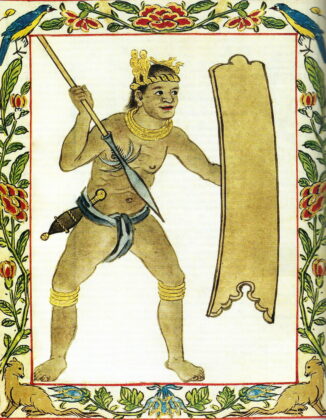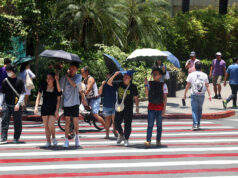A look at our bloody past
By Jonathan Best
Book Review
Púgot: Head Taking, Ritual Cannibalism, and
Human Sacrifice in the Philippines
By Narciso C. Tan
Vibal Foundation –
Academica Filipina.
shop@vibalgroup.com.
Hardbound, P2,500
NARCISO C. Tan’s long-awaited study of the ritual practices of the Philippine’s many ancestral, ethnolinguistic groups has finally been launched by the Vidal Foundation as part of its Academica Filipina series of books on Philippine history, culture, and the arts. This latest publication is in the form of an elegant coffee table book, fully illustrated, annotated and designed with all the necessary addendum of a truly scholarly work. The title is Púgot: Head Taking, Ritual Cannibalism, and Human Sacrifice in the Philippines. The subject matter is both disturbing and controversial; however, Tan manages to handle it in such a professional manner that despite the gruesomeness at times, it never fails to be fascinating and informative. It rises above the sensational aspects of the violent subject matter and thoroughly explores the deep religious and spiritual beliefs which evidently sustained these ritualistic practices over centuries and possibly millennia before the modern Filipino nation fully evolved. Some of these lingering practices have been documented in remote mountainous areas as late as the mid-20th century during the Japanese occupation and the chaos of World War II.
The book is divided into three sections devoted to the three rituals noted in the title but in reverse order; human sacrifice, ritual cannibalism, and head taking. Barbara Watson Andaya of the University of Hawai’i provides a foreword which clearly establishes the importance of Mr. Tan’s book in the long line of studies and anecdotal references to “ritualistic violence” in early and even modern Philippine ethnographic history. Each section of the book provides numerous quotes relating to the given subject matter in both the original language of the source and accompanied by an English translation. As an added benefit to the reader, Mr. Tan includes brief biographical sketches in the footnotes for all the major scholars and informants he quotes, giving their names, dates, and when they were active in the Philippines if they were foreigners, which the majority of them were.
The research covers practices documented from Mindanao and Jolo in the south, to Apayao and the Batanes Islands in the north. From one end of the Philippine archipelago of 7,641 island to the other and with 77 different ethnolinguistic groups listed. The majority of information comes from groups in Mindanao or the Mountain Province region in northern Luzon. The author makes a point of only listing practices which can be defined as community sanctioned rituals, either of a religious nature or condoned by the local community as legitimate acts associated with ongoing regional conflicts. This criterion becomes somewhat ambiguous at times because the practice of slave taking and trading both had a commercial aspect and also was in many instances tied to human sacrifice. Racial attacks against the indigenous Negrito population were not necessarily motivated by any religious beliefs, and attacks against Spanish colonizers, lowland Christian communities, or Japanese occupiers during the war would be better characterized as political or military actions.
The rituals that Narciso Tan discusses can be broadly characterized as acts of supplication or acts to propitiate good or evil preternatural entities or to placate the spirits of the constantly watchful deceased ancestors or powerful members of the community who had recently died. Killing one or more male or female slaves or a loyal servant or even the wife of an important man so that the victim’s spirit could accompany the dead and serve him or her in the afterlife was a common belief. In some cases, the bravery or strength of the victim of a head-taking was believed to be transferred of the warrior who made the killing. Eating the victim’s heart, liver, or brain was also believed to magically transfer beneficial powers to warriors or to the male shaman or female priestesses who officiated at sacrificial rituals on behalf of the community.
In some instances, the entire community would be involved in these gruesome rituals, women and children included. Their aim was to placate spirits hungry for blood to insure good harvests, protection from illness and natural disasters such as typhoons or volcanic eruptions, or for protection from headhunting and slave trading raids from hostile neighbors or marauding pirate fleets. To win a wife and ensure a fertile marriage, young men were expected to bring home a head or at least be part of a successful head-taking raid.
When a community acquired a slave to sacrifice or a head or several heads or even a few body parts from a successful raid or an outright battle, it was cause for a cañao or festive celebration with many laudatory speeches, hours of dancing to the gansa (brass gongs), feasting and binge drinking. With the slow yet relentless pressure over the centuries of the more civilizing influences of Islam and Christianity, many of these violent rituals died out and animals such as carabaos, pigs, or chickens were substituted for hapless human victims. After 1900, American colonial administrators, more intent on building modern infrastructure, and mining for gold than on saving souls, were better able than the obsessively religious Spanish administration to pacify outlying and inaccessible regions. Eventually most of these cruel and barbaric practices died out as schools, clinics, and modern transportation systems were developed.
The author provides useful tables in each section listing the numerous groups involved and their specific practices.
Narciso Tan, a graduate of Xavier College in Manila, spent 10 years combing through libraries here and abroad, accompanied by his wife, Sharon, interviewing any scholars who could add to his almost encyclopedic archive of historical source material. His book includes quotations from rarely seen 11th century Chinese historical records, early Spanish colonizers such as Antonio Pigafetta, Juan de Salcedo, Sinabaldo de Mas, and numerous Catholic missionaries and chroniclers from the 17th through the 19th century such as Francisco Colin, Manuel Buzeta, Fr. Pablo Pastells, and many others. In the late 19th century, famous French and German anthropologists made extended visits to the Philippines such as Dr. Joseph Montano who researched in Mindanao, and Fedor Jagor and Alfred Marche who traveled in the Visayas, and Hans Meyer, Alexander Schadenberg, and Otto Scheerer who explored the Mountain Province region. The Americans arrived late on the scene but Fay Cooper Cole, R. F. Barton, Otley Beyer, Albert and Maud Jenks, Laura Benedict, Dean Worcester, and David Barrows all published important findings. More recently, William Henry Scott of Sagada published numerous books and articles which were valuable sources for Mr. Tan’s project. Although he never visited the Philippines, Jose Rizal’s good friend Dr. Ferdinand Blumentritt wrote extensively on the anthropological history of migrating Filipino ethnic groups.
The author repeatedly compares and contrasts similar violent ritualistic practices found in neighboring Southeast Asian countries, Polynesia, South Asia, and China so there can be no question of this study being a biased critic of Filipinos or their early history and evolutionary development. Some of his sources’ findings have been questioned as sensational exaggerations or racially and religiously prejudiced, but these issues Mr. Tan fully acknowledges and tries to offer as much explanatory context as possible so the reader can fully evaluate any questionable or biased misinformation. The breadth of his own research is overwhelming as evidenced in the 52-page glossary, bibliography, and index at the back of the book. This alone is a veritable gold mine of information and sources for anyone studying Philippine history.
The book is fully illustrated in color with reproductions of antique prints, maps, photographs, and drawings, from the Boxer Codex to National Geographic magazine, and many other sources interspersed with illustrative watercolors by talented local artists.
I first met Narciso Tan several year ago while he was doing research at the Ortigas Foundation Library and lent him four vintage photographs from my collection which he added to “An Early 20th Century Photo Folio of Headhunting Rituals” which he has placed at the end of the main text of his book. This folio of 28 sepia toned photos taken in the early 20th Century give the reader a somewhat lurid glimpse of the primitive rituals which existed centuries ago, common not only to the Philippines but to all evolving societies over the millennia.
Púgot is not an easy read but it is always fascinating and an invaluable source of arcane information regarding rarely explored aspects of the Philippine past.
Jonathan Best is a senior consultant at the Ortigas Foundation Library in Greenhills, Metro Manila.





